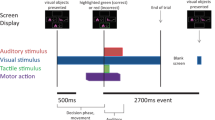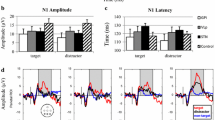Abstract
We studied cognitive functions related to processing sensory and motor activities in the basal ganglia (BG), specifically in the putamen and in cortical structures forming the BG-frontocortical circuits. Intracerebral recordings were made from 160 brain sites in 32 epilepsy surgery candidates. We studied P3-like potentials in five different tests evoked by auditory and visual stimuli, and two sustained potentials that are related to cognitive activities linked with movement preparation: BP (Bereitschaftspotential) and CNV (contingent negative variation). We compared the presence of a potential with a phase reversal or an amplitude gradient to the absence of a generator. All of the studied cognitive potentials were generated in the BG; the occurrence in frontal cortical areas was more selective. The frequency of all but one potential was significantly higher in the BG than in the prefrontal and in the cingulate cortices. The P3-like potentials elicited in the oddball paradigm were also more frequent in the BG than in the motor/premotor cortex, while the occurrence of potentials elicited in motor tasks (BP, CNV, and P3-like potentials in the CNV paradigm) in the motor cortex did not significantly differ from the occurrence in the BG. The processing of motor tasks fits with the model by Alexander et al. of segregated information processing in the motor loop. A variable and task-dependent internal organisation is more probable in cognitive sensory information processing. Cognitive potentials were recorded from all over the putamen. The BG may play an integrative role in cognitive information processing.







Similar content being viewed by others
References
Alexander GE, DeLong MR, Strick PL (1986) Parallel organization of functionally segregated circuits linking basal ganglia and cortex. Ann Ret Neurosci 9:357–381
Bareš M (2001) Parallel processing of cognitive information in the frontal cortex and the basal ganglia. Homeostasis 41:55–57
Bareš M, Rektor I (2001) Basal ganglia involvement in cognitive and sensory processing. A SEEG CNV study in human subjects. Clin Neurophysiol 112:2022–2030
Baudena P, Halgren E, Heit G, et al (1995) Intracerebral potentials to rare target and distractor auditory and visual stimuli. II. Frontal cortex. Electroenceph Clin Neurophysiol 94:251–264
Brázdil M, Rektor I, Dufek M, et al (1999) The role of frontal and temporal lobes in visual discrimination task-depth ERP studies. Clin Neurophysiol 29:339–350
Brázdil M, Rektor I, Daniel P, et al (2001) Intracerebral event-related potentials to subthreshold target stimuli. Clin Neurophysiol 112:650–661
Brotchie P, Iansek R, Horne MK (1991) Motor function of the monkey globus pallidus. Brain 114:1685–1702
Brunia CHM, Damen EJP (1988) Distribution of slow brain potentials related to motor preparation and stimulus anticipation in a time estimation task. Electroenceph Clin Neurophysiol 69:234–243
Cui RQ, Egkher A, Huter D, et al (2000) High resolution spatiotemporal analysis of the contingent negative variation in simple or complex motor tasks and a non-motor task. Clin Neurophysiol 111:1847–1859
Cummings JL (1993) Frontal-subcortical circuits and human behavior. Arch Neurol 50:873–880
Dubois B, Malapani C, Verin M, et al (1994) Fonctions cognitives et noyaux gris centraux: Le modele de la maladie de parkinson. Rev Neurol (Paris) 150,11:763–770
Goldman-Rakic PS, Selemon LD (1990) New frontiers in basal ganglia research. TINS 13:241–244
Graybiel AM (1997) The basal ganglia and cognitive pattern generators. Schizophr Bull 23:459–469
Halgren E, Baudena P, Clarke JM, et al (1995a) Intracerebral potentials to rare target and distractor auditory and visual stimuli. I. Superior temporal plane and parietal lobe. Electroenceph Clin Neurophysiol 94:191–220
Halgren E, Baudena P, Clarke JM (1995b) Intracerebral potentials to rare target and distractor auditory and visual stimuli. II. Medial, lateral and posterior temporal lobe. Electroenceph Clin Neurophysiol 94:229–250
Halgren E, Marinkovic K, Chauvel P, et al (1998) Generators of the late cognitive potentials in auditory and visual oddball tasks. Electroenceph Clin Neurophysiol 106:156–164
Ikeda A, Luders HO, Burgesss RC, et al (1992) Movement-related potentials recorded from supplementary motor area and primary motor cortex. Brain 115:1017–1043
Joel D (2001) Open interconnected model of basal ganglia-thalamocortical circuitry and its relevance to the clinical syndrome of Huntington’s disease. Mov Disord 16:407–423
Kimura M (1986) The role of primate putamen neurons in the association of sensory stimuli with movement. Neurosci Res 3:436–443
Kimura I, Ohnuma A, Seki H, et al (1990) Cognitive impairment in Parkinson’s disease assessed by visuomotor performance system and P300 potential. Tohoku J Exp Med 161:155–165
Kornhuber HH, Deecke L (1965) Hirnpotentialänderungen bei Willkürbewegungen und passiven Bewegungen der Menschen: Bereitschaftspotential und reafferente Potentiale. Pflugers Archiv 284:1–17
Kropotov JD, Ponomarev VA (1991) Subcortical neurol correlates of component P300 in man. Electroenceph Clin Neurophysiol 78:40–49
Kropotov JD, Etlinger SC, Ponomarev VA, et al (1992a) Event-related neuronal responses in the human strio-pallido-thalamic system. I. Sensory and motor functions. Electroenceph Clin Neurophysiol 84:373–385
Kropotov JD, Etlinger SC, Ponomarev VA, et al (1992b) Event-related neuronal responses in the human strio-pallido-thalamic systém. II. Cognitive functions. Electroenceph Clin Neurophysiol 84:386–393
Lamarche M, Louvel J, Buser P, Rektor I (1995) Intracerebral recordings of slow potentials in a contingent negative variation paradigm: an exploration in epileptic patients: Electroenceph Clin Neurophysiol 95:268–276
Libet B (1985) Unconscious cerebral initiative and the role of conscious will in voluntary action. Behav Brain Sci 8:529–566
Marsden CD (1980) The enigma of the basal ganglia and movement. TINS 3:284–287
Middleton FA, Strick PL (2000) Basal ganglia output and cognition: evidence from anatomical, behavioral, and clinical studies. Brain and Cognition 42:183–200
Parent A, Cicchetti F (1998) The current model of basal ganglia organization under scrutiny. Mov Disord 13:199–202
Parent A, Lévesque M, Parent M (2001) A re-evaluation of the current model of the basal ganglia. Parkinsonism&Related Disord 7:193–198
Rektor I (2000) Long-lasting simultaneous activation of cortical and subcortical in movement preparation and execution. Clinical neurophysiology at the beginning of the 21st century. Clin Neurophysiol 53[Suppl]: 192–195
Rektor I (2002) Scalp-recorded Bereitschaftspotential is the result of the activity of cortical and subcortical generators—a hypothesis. Clin Neurophysiol 113:1998–2005
Rektor I, Feve A, Buser P, et al (1994) Intracerebral recording of movement related readiness potentials in epileptic patients: Electroenceph Clin Neurophysiol 90:273–283
Rektor I, Louvel J, Lamarche M (1998) Intracerebral recording of potentials accompanying simple limb movements: a SEEG study in epileptic patients: Electroenceph Clin Neurophysiol 107:227–286
Rektor I, Kaňovský P, Bareš M, Louvel J, Lamarche, M (2001a) Evoked potentials, ERP, CNV, readiness potential, and movement accompanying potential recorded from the posterior thalamus in human subjects. A SEEG study. Clin Neurophysiol 31:1–9
Rektor I, Bareš M, Kaňovský P, Kukleta M (2001b) Intracerebral recording of readiness potential induced by a complex motor task. Mov Disord 16:698–704
Rektor I, Bareš M, Kubová D (2001c) Movement-related potentials in the basal ganglia: a SEEG readiness potential study. Clin Neurophysiol 112:2146–2153
Rektor I, Kaňovský P, Bareš M, Brázdil M, Streitová H, Klajblová I, Kuba R, Daniel P (2003) A SEEG study of ERP in motor and premotor cortices and in the basal ganglia. Clin Neurophysiol 114:463–471
Romo R, Scarnati E, Schultz W (1992) Role of primate basal ganglia and frontal cortex in the internal generation of movements. II. Movement-related activity in the anterior striatum. Exp Brain Res 91:385–395
Stein S, Volpe BT (1983) Classical “parietal” neglect syndrome after subcortical right frontal lobe infarction. Neurology 33:797–799
Takada M, Tokuno H, Nambu A, et al. (1998) Corticostriatal projections from the somatic motor areas of the frontal cortex in the macaque monkey: segregation versus overlap of input zones from the primary motor cortex, the supplementary motor area, and the premotor cortex. Exp Brain Res 120:114–128
Talairach J, Szikla G, Tournoux P, et al (1967) Atlas d’anatomie stereotactique du telencephale. Masson, Paris
Vaughan HG, Weinberg H, Lehmann D, et al (1986) Approaches to defining the intracranial generators of event-related electrical and magnetic fields. In: McCallum WC, Zappoli R, Denoth F (eds) Cerebral psychophysiology: studies in event-related potentials. EEG. Elsevier, Paris, pp 505–544
Verleger R, Wascher E, Wauschkuhn B, et al (1999) Consequences of altered cerebellar input for the cortical regulation of motor coordination, as reflected in EEG potentials. Exp Brain Res 127:409–422
Walter WG, Cooper R, Aldridge VJ, et al (1964) The contingent negative variation: an electro-cortical sign of sensorimotor association in man. Electroenceph Clin Neurophysiol 17:340–344
Acknowledgement
Supported by research program MŠ ČR 112801.
Author information
Authors and Affiliations
Corresponding author
Rights and permissions
About this article
Cite this article
Rektor, I., Bareš, M., Kaňovský, P. et al. Cognitive potentials in the basal ganglia—frontocortical circuits. An intracerebral recording study. Exp Brain Res 158, 289–301 (2004). https://doi.org/10.1007/s00221-004-1901-6
Received:
Accepted:
Published:
Issue Date:
DOI: https://doi.org/10.1007/s00221-004-1901-6




